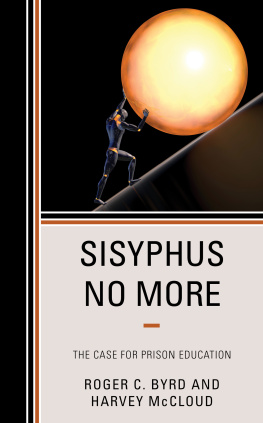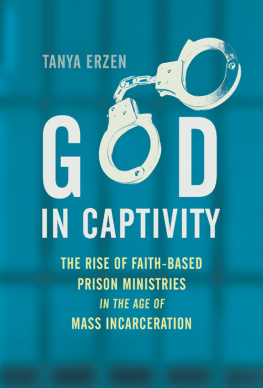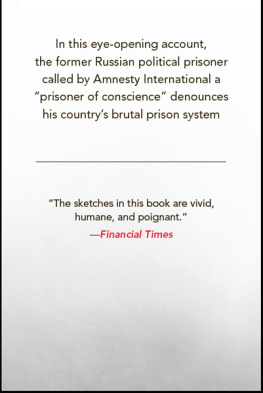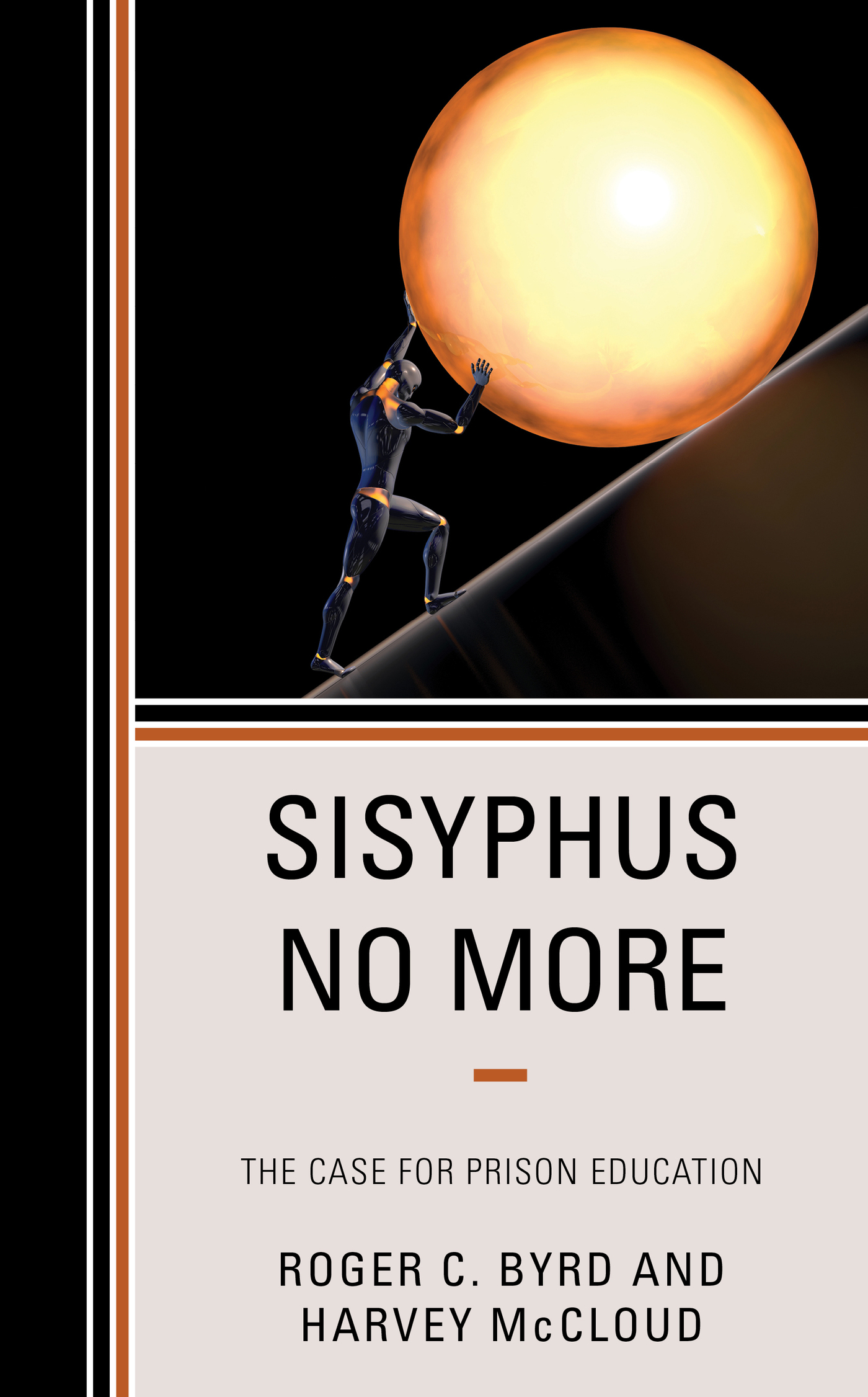Sisyphus No More
Sisyphus No More
The Case for Prison Education
Roger C. Byrd and Harvey McCloud
ROWMAN & LITTLEFIELD
Lanham Boulder New York London
Published by Rowman & Littlefield
An imprint of The Rowman & Littlefield Publishing Group, Inc.
4501 Forbes Boulevard, Suite 200, Lanham, Maryland 20706
www.rowman.com
6 Tinworth Street, London SE11 5AL, United Kingdom
Copyright 2021 by The Rowman & Littlefield Publishing Group, Inc.
All rights reserved. No part of this book may be reproduced in any form or by any electronic or mechanical means, including information storage and retrieval systems, without written permission from the publisher, except by a reviewer who may quote passages in a review.
British Library Cataloguing in Publication Information Available
Library of Congress Cataloging-in-Publication Data
Library of Congress Control Number: 2020946484
ISBN 978-1-5381-3660-7 (cloth : alk. paper)
ISBN 978-1-5381-3661-4 (electronic)
 TM The paper used in this publication meets the minimum requirements of American National Standard for Information Sciences Permanence of Paper for Printed Library Materials, ANSI/NISO Z39.48-1992.
TM The paper used in this publication meets the minimum requirements of American National Standard for Information Sciences Permanence of Paper for Printed Library Materials, ANSI/NISO Z39.48-1992.
This book is dedicated, with love, to each of our wives, April and Teresa. Thank you both for your constant loving support throughout this project.
Preface
For most Americans, the human side of incarceration is hidden behind the razor-wired walls of state and federal prisons typically built in relatively isolated areas. There, nearly 1.5 million prisoners pass lives of extreme regimentation in brutally unforgiving prison environments. Some of these people have committed heinous crimes for which they will never again wake to a free day. The great majority, however, after at least a year of dreary sameness and often many more, finally will finish serving their sentence or be released on parole. They then will walk away from the walls and razor wire to try to make their way in society. Though impending release is a reason for a prisoner to celebrate, it also can be a source of anxiety and fear. How will he be able to handle merging into the world outside? How will he earn a living? Where will she live? How will he be able to pay the restitution fees or child support that may be demanded as a condition of parole?
The prisoners about to be released who are most troubled by such questions may be those who are educationally unprepared for reintegration into society. These are the multitude of incarcerated men and women whose education before and within prison was grievously inadequate. This vast group includes hundreds of thousands who have no postsecondary education or even a high school degree or GED certificate, individuals who often have no marketable skills and may even lack the ability to read and complete a job application. For these people especially, release to the outside world can present an enormous challenge.
What makes the challenge even more formidable is that as they make their entrance into the world outside, released prisoners already have one big strike against thembeing a convicted felon. That fact alone is enough to close many doors that could lead to gainful employment and decent housing. Add lack of education to the mix, and the challenge becomes huge. In an increasingly technological society, obtaining a good job requires proficiency in verbal, math, and reasoning skills. Job seekers lacking such competencies typically are condemned to the lowest-paying, most humble employment, offering nothing more than subsistence pay with minimal chance of advancement. Yet, poorly educated former prisoners are unlikely to have funds or opportunity to pursue additional education that might enable them to attain a higher-paying job.
The dismal result for those released from confinement with deficient education is that their dream of freedom may quickly become a realization that they have been sentenced to a new type of confinement. They observe fellow citizens enjoying nice homes, new cars, and money to spend on entertainment and vacations and conclude that these are rewards they will never have if they stay within legal boundaries. Therefore, it is not surprising for many released prisoners to open themselves to illegitimate ways to increase their income, whether through theft, drug trafficking, or some other criminal enterprise. And, not surprising, many soon find their way back to the razor-wired walls.
Recidivismdefined in this book as the reincarceration of released prisonersis alarmingly high in the U.S. justice system. The five-year recidivism rate for individuals released from state prisonsthe percent rearrested and sent back to confinement within five years of their releasewas found by the U.S. Bureau of Justice to be more than 55 percent.
The phenomenon of recidivism is a reminder of the story of Sisyphus, a mythological Greek king. When Sisyphus violated the rules of the Greek gods, they punished him by forcing him to push a large boulder up a tall hill. When he reached the top, he had to let the boulder roll back down; he was then forced to push it back up again. He was required to undergo this punishment for eternity. The similarity of the fate of Sisyphus to the situation of todays prisoners is that their punishment does not end when they have completed their mandated time in prison. After release, they typically face onerous challenges in their efforts to reintegrate into a largely unwelcoming society. Their ongoing punishment, in the form of social and employment constraints, financial obligations, collateral consequences, and lost opportunities, is for a lifetime. And a grievous consequence of societys continuing sanctions of released prisoners is an increased likelihood of making their way back to prison walls.
Of course, multiple factors determine whether a released prisoner does or does not recidivate. Notwithstanding, it is our contention that one of the main factors affecting the likelihood of returning to prison is the individuals educational level. While providing some education to prisoners is a virtually universal activity in both public and private U.S. correctional institutions, these programs typically are seriously limited in their range and effectiveness, largely due to lack of funds. As a result, many prisoners discharged into the larger society have meager intellectual tools with which to make their way.
In this book, we make the case for federal and state governments to invest substantially increased funds in prison education programs. We present our argument on psychological, sociological, ethical, and financial grounds. Admittedly, increasing prison-based education will not, on its own, empty our prisons; but we hold that it will reduce prison populations significantly and thereby benefit society in important ways. Today, many government bodies and much of our society are waking to the necessity of reducing a bloated prison population that has grown immensely in the past several decades. We hold that one of the most effective ways to promote that reduction is to increase targeted prison education programs substantially, providing former prisoners tools to help them overcome obstacles and find success as they rejoin law-abiding society.
The necessity for more and better prison education goes hand in hand with the need for a new sensibility in the nations attitude toward those who have been caught up in the criminal justice system and sent to prison. The first part of this new sensibility is to realize that what we should hope for and work toward is not the social exclusion of former prisoners that they typically encounter today. That does no good for anyone. And for that reason, it makes no sense. What does make sensenot only for the individuals themselves, but also for their families and communities and for society as a wholeis the full reintegration of former prisoners into free society. As we suggested above and will detail in later chapters, in many ways these people are given the cold shoulder and made into second-class citizens after their release. This is a major factor that sets many of them on the road to becoming a modern-day Sisyphus, while promoting recidivism.
Next page





 TM The paper used in this publication meets the minimum requirements of American National Standard for Information Sciences Permanence of Paper for Printed Library Materials, ANSI/NISO Z39.48-1992.
TM The paper used in this publication meets the minimum requirements of American National Standard for Information Sciences Permanence of Paper for Printed Library Materials, ANSI/NISO Z39.48-1992.